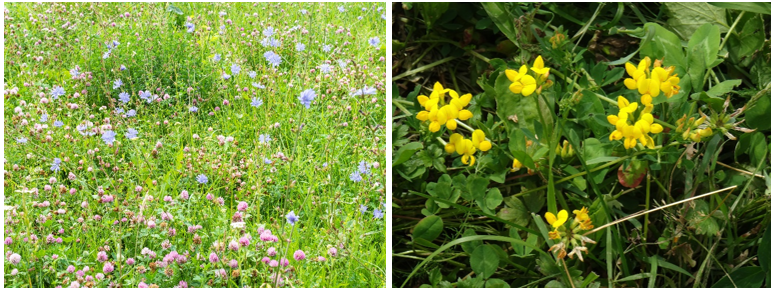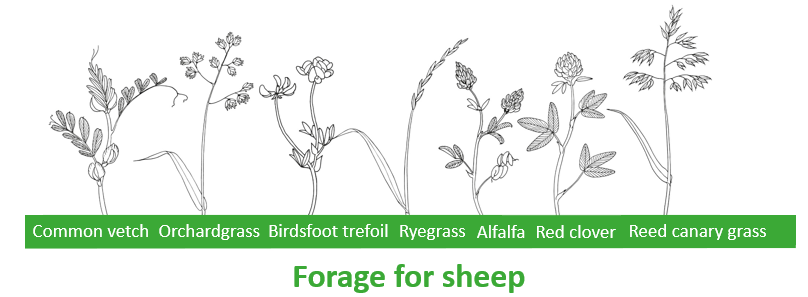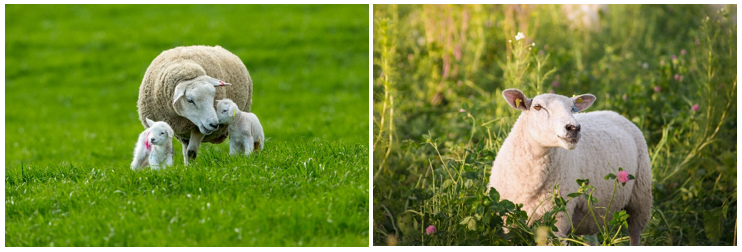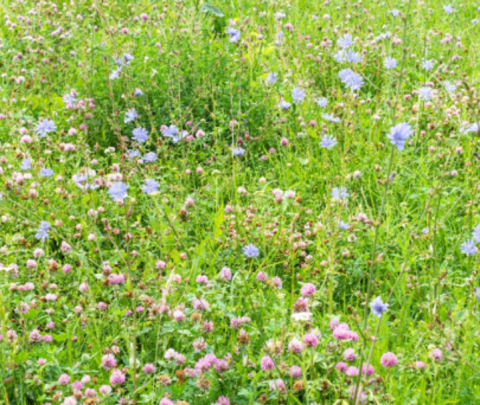- Herbal leys can significantly improve the nutritional value of grassland when compared to conventional perennial ryegrass and clover swards.
- Grassland species containing high levels of secondary metabolites, particularly tannins, can be used within parasite control programmes to effectively reduce parasite burdens and reduce the reliance on chemical anthelmintic compounds.
- Herbal leys have the potential to significantly improve lamb performance while simultaneously reducing the requirement for inputs such as fertiliser and supplementary feed.
Today, the majority of improved, highly productive grassland consists of less than five different plant species. Swards are often composed of perennial ryegrass and white clover that have been bred for maximal production. These swards have become popular with livestock producers as they are highly palatable, highly digestible, and have relatively high dry matter, crude protein and metabolisable energy values, providing high quality fresh and ensiled forages. Swards based on perennial ryegrass mixtures also establish rapidly, facilitating optimal grassland management. However, when utilising such monoculture pastures two primary challenges that impact the daily liveweight gain of lambs remain. These challenges are achieving adequate nutritional quality through forage, without significant reliance on concentrates, and effectively managing parasite burdens. These challenges are particularly acute in upland areas where the growing season is relatively short, and environmental conditions limit grass growth and support increased parasite prevalence.
To help mitigate the impacts of these challenges, farmers are increasingly looking to the use of herbal leys within their grazing systems. A herbal ley, also known as a multi-species pasture, is characterised by a combination of 15-40 different grass, legume, and herb species. Herbal leys have been associated with a range of health and production benefits for livestock.
These benefits are being utilised on an increasing number of farms, and in Wales, one European Innovation Partnership project set out to investigate whether herbal leys affect the health and performance of growing lambs, when compared to a more conventional ryegrass and clover pasture.
How can herbal leys help?
One of the largest challenges to ruminant livestock producers is the prevalence of internal parasitic worms, as the performance of grazing lambs is inversely correlated with parasite burden, and resistance to pharmaceutical anthelmintic products is increasing. Anthelmintic resistance in sheep can increase lamb mortality and reduce productivity by up to 50%. Since the discovery of new effective anthelmintic chemical groups for use in the agricultural sector is unlikely, adopting alternative approaches for parasite control is essential.
In grazing systems, increasing sward biodiversity is one strategy to decrease the reliance on chemical anthelmintics. Diverse herbal ley swards are thought to act via three different mechanisms to decrease parasite burden. These include 1) providing physical barriers to parasite survival and infection, 2) direct anthelmintic effects on parasites, and 3) increasing the nutritive value of grassland.
Physical Characteristics
Herbal leys composed of many different plant species provide physical sward characteristics that are more unsuitable for the development, survival and migration of parasite larvae than when compared to monoculture swards. Common examples of plant species included in herbal leys are listed in Table 1.
Table 1: Common species included in herbal leys.
|
Grasses |
Legumes |
Herbs |
|
Meadow fescue (F. pratensis) |
Birdsfoot trefoil (L. corniculatus) |
Chicory (C. intybus) |
|
Perennial ryegrass (L. perenne) |
Big trefoil (L. pedunculatus) |
Wormwood (A. absinthium) |
|
Italian ryegrass (L. multiflorum) |
Alfalfa (M. sativa) |
Mugwort (A. vulgaris) |
|
Cocksfoot (D. glomerata) |
Sainfoin (O. viciifolia) |
Burnet (S. minor) |
|
Timothy (P. pratense) |
Sulla (H. coronarium) |
Plantain (P. major) |
|
|
Red clover (T. pratense) |
Sheeps parsley (P. crispum) |
|
|
White clover (T. repens) |
|
As herbal leys are composed of many different plant species, with leafy matter at various sward heights, parasites are inhibited from translocating from faecal matter to leafy material and the ingestion of parasites which reside at ground level is largely reduced. The presence of tall species within a heterogenous sward also reduces the dense ground habitat required for the maintenance of moisture films, necessary for optimal parasite reproduction and migration. Tall species also increase parasite exposure to the elements, increasing the likelihood of desiccation, since nematodes are susceptible to extremes of temperature.
One study investigating whether plant structure affects parasite populations compared birdsfoot trefoil and chicory with ryegrass. The study found that birdsfoot trefoil and chicory have the potential to reduce infectious stage parasitic larvae burdens by >58% and 63% respectively, when compared to perennial ryegrass, indicating that the sward structure significantly impacts the survival and migration of parasitic nematodes.

Plants such as red clover and chicory (left), and birdsfoot trefoil (right) are commonly included in herbal leys for grazing livestock.
Anthelmintic Properties
Grassland plants are a particularly rich source of plant secondary metabolites, many of which have anthelmintic properties. The most widely studied of these are leguminous species, high in secondary metabolites called condensed tannins. Condensed tannins have been shown to have potent anthelmintic activity in laboratory studies, through strong effects on larval motility and migration. When ingested, tannins are thought to interact with nematode proteins and inhibit enzyme production, modifying the host-nematode environment, inhibiting nematode function and reducing parasite survival, growth and reproduction.
One study which profiled the anthelmintic compounds of seventeen common grassland species found that the herbal leys providing the highest levels of multiple anthelmintic compounds were those that included plants with high tannin content such as alfalfa, common sainfoin, and chicory. Alfalfa and common sainfoin also contain other compounds such as saponins, caffeic acid, thymol, and geraniol, which decrease parasitic infection by decreasing egg survival and larval and adult mobility.
Many studies have demonstrated the effects of herbal ley species on parasite burdens in ruminants. One particular study, using seventy-two Lleyn lambs investigated the effect of feeding a single herbal species on parasite burden. Monocultures of chicory and birdsfoot trefoil were compared to a common ryegrass and white clover mix. Lambs fed chicory were significantly heavier, with a significantly higher body condition score after thirty-five days of feeding, than those lambs fed birdsfoot trefoil and ryegrass with white clover. Those lambs fed birdsfoot trefoil and chicory had lower faecal egg counts and fewer abomasal and small intestine parasites than those lambs fed perennial ryegrass with clover. Although this study used monocultures rather than mixed swards, a practice that would not be repeated on-farm, the results indicate that these plants have the potential to contribute to parasite control regimens.
Nutritional status
When grazing herbal leys an increase in livestock performance is often attributed to the anthelmintic activity of the ley. However, increases in performance may also be due to the enhanced nutritional quality of the sward. When compared to the average perennial ryegrass and clover mixes, herbal leys often have an enhanced mineral and trace element composition. For example, levels of potassium, sodium, calcium, sulphur, magnesium, and zinc are often higher in chicory, plantain, dandelion, and broad-leaved dock than perennial ryegrass and white clover.
Increasing the biodiversity of plants within the sward can also increase biomass yield. One study demonstrated how the inclusion of 20% plantain in a perennial ryegrass and red clover seed mixture increased overall dry matter yield by an average of 9.5%. Herbal leys can also provide the crude protein requirements of growing lambs through the inclusion of leguminous species. Species such as sainfoin have a high duodenal utilisable crude protein content and are highly palatable to sheep when fed either fresh or ensiled. While leguminous species don’t typically provide the same level of metabolizable energy as perennial ryegrass (which provides an average of 11.7 MJ/Kg DM) plants such as sainfoin can provide 9.5 MJ/Kg DM of metabolizable energy, which is comparable with the levels provided by grasses such as timothy, sweet meadow grass, red fescue and creeping bent.
Tannins can also have direct effects on digestibility. The binding of tannins to proteins prevents the degradation of proteins within the rumen, without affecting microbial protein synthesis, therefore increasing the quantity of protein available for absorption in the small intestine. This enhanced protein availability increases the nutritional value of the sward. When combined with improved mineral and trace element status, mixed herbal swards are expected to improve the host immune response to parasite burdens.

Effects on productivity
A rapidly growing lamb can achieve daily liveweight gains of 250g. To support this an ewe requires 3-4% of her bodyweight as dry matter per day, and following weaning, the lamb will require 4% of its bodyweight as dry matter per day. If the required daily intake for growth cannot be met by the sward then supplementary feeding will be required to maintain growth. While perennial ryegrass and white clover mixes are highly productive under high nitrogen inputs, maximal yield can be difficult to achieve in areas where high nitrogen inputs are not optimal, such as on upland pastures. However, multispecies swards can produce equivalent dry matter yields, under relatively low nitrogen treatments. When combined with their anthelmintic properties, the increased nutritional value of herbal leys can have significant impacts on production.
For example, it has been demonstrated that when grazing red clover, compared to perennial ryegrass and white clover, ewe milk production can increase by 24%, and weaned lamb growth rates can increase by 20%. Lambs grazing herb and clover mixes, consisting of chicory, plantain, white clover and red clover have been shown to achieve greater daily gains, increased live weights and final carcass weights when compared to lambs grazing traditional perennial ryegrass-clover based pastures. One study that compared the performance of perennial ryegrass, perennial ryegrass with white clover, a six species sward, and a nine species sward, found that ewes grazing the six and nine species swards had heavier liveweights and body condition scores than ewes grazing perennial ryegrass. Lambs grazing the six species sward were also significantly heavier than lambs on all other sward types, while lambs grazing perennial ryegrass required the highest number of days to reach slaughter weight. Lambs grazing the six and nine species swards also required fewer anthelmintic treatments than lambs grazing the perennial ryegrass and perennial ryegrass with white clover swards.
Many studies have concluded that feeding high value legume and herb species enable summer lamb growth rates of approximately 250g per day, in contrast to an average of 80-150g per day on perennial ryegrass and white clover alone. Examples of the daily liveweight gains achieved by different plant species commonly included in herbal leys are included in Table 2.
Table 2: Examples of liveweight gains of lambs grazing ryegrass and white clover compared to legume and/or herb species.
|
Forage Species |
Average liveweight gain (g/day) |
|
119 |
|
|
247 |
|
|
311 |
|
|
292 |
|
|
258 |
|
|
311 |
|
|
222 |
Many of the increases in daily liveweight gains observed in sheep have occurred when plants with a condensed tannin content above 3% dry matter, such as sulla, sainfoin, big trefoil, birdsfoot trefoil and chicory have been grazed. At high concentrations however, tannins have been reported to reduce voluntary food intake and decrease nutrient digestibility. Therefore, a tannin content between 3-8% dry matter is optimal to balance the palatability, digestibility, and voluntary intake of these species with their anthelmintic effects.
In many studies, the effects on daily live weight gain in lambs grazing herbal leys have been achieved by allowing lambs unrestricted intakes by ensuring the swards did not drop below 5cm in height. As this is an important management consideration when using herbal leys, for maximum production, a rotational grazing management strategy is optimal.

Livestock are commonly produced on swards composed of perennial ryegrass and clover (left). Increasing the diversity of the sward (right) can provide valuable benefits that can improve ewe and lamb performance.
Additional benefits of herbal leys
An increased number of nitrogen fixing species within the sward increases the nitrogen content of the soil and reduces the reliance on chemical fertilisers or slurry. The use of various grasses, legumes and herbs also improves soil quality and increases pasture resistance to drought and flooding due to the variation in tiller and root depth. The addition of alfalfa to a pasture, for example, has been shown to increase dry matter yield, as alfalfa can extract water from a deeper soil depth. Resistance to conditions such as drought are increasingly important sward characteristics as drought conditions, which are likely to become more frequent, limit the productivity of perennial ryegrass and clover mixes.
Increasing grassland biodiversity can also have beneficial effects on methane emissions, increasing the sustainability of livestock production, as the proportion of energy lost to methane is lower in animals fed legumes compared to grasses. Lambs grown to their slaughter weight more quickly also consume less feed and are therefore more efficient, producing fewer greenhouse gas emissions.
Increasing grassland biodiversity also increases the availability of valuable habitat for a variety of pollinating insects, birds and small mammals. One European Innovation Partnership project titled ‘pasture for pollinators’ successfully used herbal leys to increase the provision of habitat for pollinating insects on farms.
Summary
Including a variety of different grass, legume and herb species within a sward has the potential to increase the nutritional quality, anthelmintic properties, and productivity of grassland. While the addition of only one extra species to a sward of perennial ryegrass is advantageous, increasing the number of species to include a wide variety of different plants has the most significant benefit.
If you would like a PDF version of the article, please contact heledd.george@menterabusnes.co.uk



